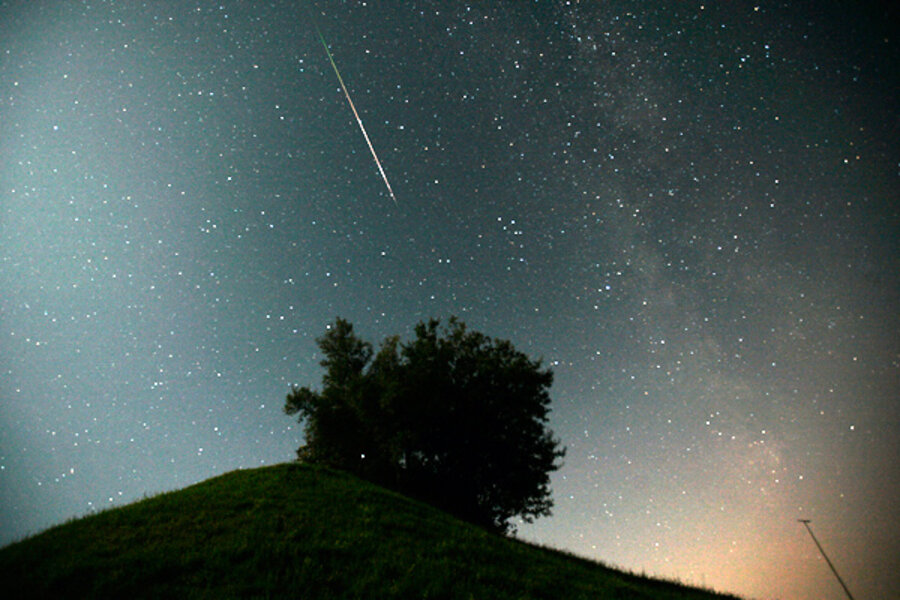Perseid meteor shower makes impressive start
Loading...
Clear skies over these next few nights and enough personal stamina to stay awake will afford a view of one of the flashiest meteor displays of the year. The annual Perseid Meteor Shower has been slowly ramping up in intensity since this past weekend and viewers from around the world have been delighted by views of these bright streaks of light darting across the night sky.
In some special cases, they've put on spectacular – albeit brief – shows. And the best is yet to come. [Top 10 Perseid Meteor Shower Facts]
On Saturday, Ernõ Berkó from Ludányhalaszi, Hungary witnessed a Perseid that he estimated at magnitude -10, or more than 100 times brighter than the planet Venus (which, along with Mars and Saturn currently adorns the southwest sky right after sunset).
IN PICTURES: Meteor showers
Excellent New England weather last weekend brought more than a thousand amateur astronomers to the 75th Stellafane Convention, just outside of Springfield, Vermont. While the emphasis was on observing the sky with telescopes, many participants also enjoyed the views of an occasional Perseid cutting a path across the sky. Every time one was seen, the watchers said: "Ooooohh!"
"On Saturday night, one bolide (exploding meteor) lit up the field," said Steve Lieber of the Astronomical Society of Long Island (ASLI). "Looked like a flash going off. Saw the vapor trail for 15-20 seconds after that."
(This sky map shows where to look to see the meteor shower.)
Peak due this week
The peak of this year's Perseids is forecast (for North America) to come during the afternoon hours on Thursday, which means that greatest number of meteors will probably be seen late that night into the predawn hours of Friday. At these times a single observer might count anywhere from 60 to 100 per hour.
But don't overlook late tonight into early Thursday morning, when about two-thirds of that number might be seen. And even late on Friday night into early Saturday hourly rates will still be respectable, though probably numbering about one-quarter to one-half of the numbers seen on the peak night. Over this weekend you can still probably catch sight of a lingering few.
Comet crumbs
The Perseid meteor shower "shooting stars"are the remnants of Comet Swift-Tuttle, which last visited the inner solar system in 1992. Every August, like clockwork, our planet Earth cuts through the "river of rubble" left behind along the orbit of the comet.
And yet, while comets are composed chiefly of frozen gas, meteors are very flimsy. They're material that has flaked off comets and they're similar in consistency to cigar ash; they litter up our solar system. Most are scarcely larger than pebbles or sand grains.
In the case of the Perseids, they come crashing into Earth's atmosphere at estimated speeds as high as 37 miles per second (60 km/s), or 133,000 mph (214,000 km/h). These tiny visitors from the cold, vast voids of stellar space, have been orbiting in the solar system for perhaps hundreds or even thousands of years, but cannot survive the shock of entry, and end up streaking across the sky in a brief, blazing finale lasting but a few seconds.
Their kinectic energy is used up in such processes as the production of light, heat and ionization. Thus, such a tiny particle bursts into incandescence from friction, producing the shooting star effect and can be seen from more than 100-miles away.
But it's really the light energy it develops, not the particle itself that we see.
Observing tips
Astronomers offer this advice: Get as far away from bright city lights as you can, although a few of the brightest meteors may be glimpsed even over the sooty curtain of large, light polluted metropolitan areas. Hope for a clear, dry night.
You can start your watch as early as 10 p.m., although the best views will come between 2 a.m. and the first light of dawn. Any lawn or rooftop can serve as an observatory when it comes to meteor watching. Relax in a lawn chair and scan the heavens from the south over toward the northeast.
They are named the Perseid meteors because their fiery trails, if extended to a common point of intersection, would seem to originate near to the Double Star Cluster in the constellation Perseus , which on mid August evenings rises from the northeast.
But their associated meteors could make their fiery plunges into the atmosphere over a wide range of the sky. As the night progresses, the stars of Perseus, which lies low to the northeast horizon before midnight, will slowly climb progressively higher into the sky. During the first part of the night, the meteors may appear to describe rather long paths across the heavens; after midnight they'll appear more like short, swift streaks.
As has already been noted, some Perseids leave particularly long-enduring trains in their wake. With binoculars one can see these trains drifting against the backdrop of the stars, indicative of swift winds in the very high atmosphere. But generally speaking, binoculars and especially telescopes are not particularly recommended because your unaided eyes can take in much larger areas of the sky.
For those who sleep through the Perseids, the next really prominent meteor shower will come in mid-December, the time of the Geminid Meteors.
- Perseid Meteor Shower Unleashes Bright Fireball
- Top 10 Perseid Meteor Shower Facts
- Gallery — 2005 Perseid Meteor Shower
Joe Rao serves as an instructor and guest lecturer at New York's Hayden Planetarium. He writes about astronomy for The New York Times and other publications, and he is also an on-camera meteorologist for News 12 Westchester, New York.
IN PICTURES: Meteor showers





